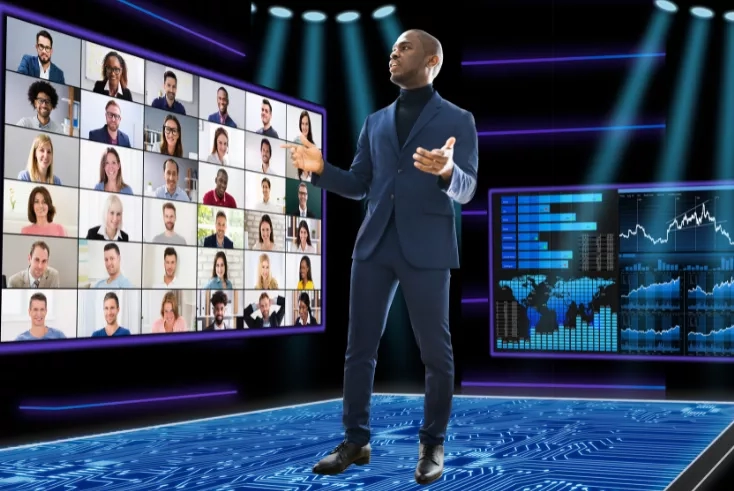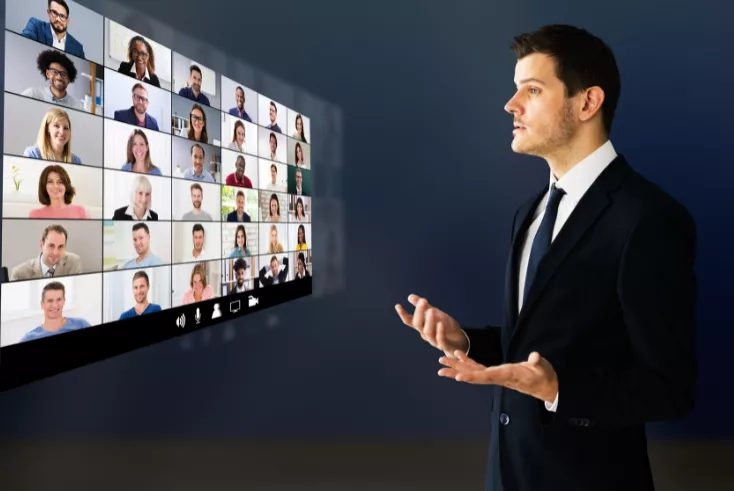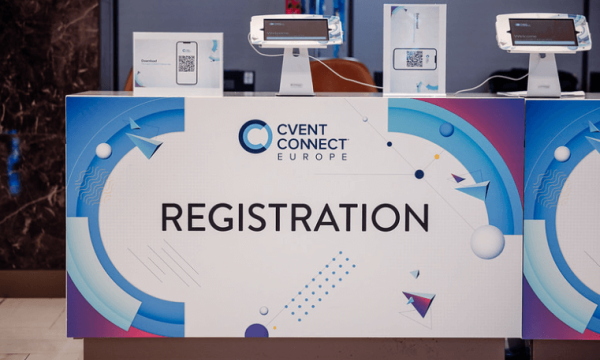The collaborative nature of a virtual summit allows planners to bring experts together online in order to spark conversation and problem-solving ideas that relate to a certain industry sector.
These digital, industry-specific events have the advantage of being able to showcase a broad quantity of knowledge from all over the world without the expense and carbon impact associated with long-haul flights, hotel nights, venue, and production hire.
As a result, you won’t need to charge high registration fees or ticket prices to break even. Greater pricing flexibility will make your virtual summit more accessible, which will no doubt equate to more registrations and a developed community, eager to engage with your content all year round.
This is why, of the many different virtual event formats to have grown out of the global pandemic, virtual summits are the most likely to remain a highly effective online tool for lead generation and knowledge sharing for years to come.
However, staging a successful virtual summit is not as easy as it may sound. Considerations and complexities include ensuring your platform partner can withstand the enlarged numbers of expected delegates and managing global speakers in different time zones while ensuring your audience has a seamless and engaging experience.
Let’s look in more detail at how to effectively produce virtual summits.
Set Your Objectives
Firstly, decide on the summit goals and objectives. Are you bringing experts together to solve a real-world problem or looking to increase awareness of an industry issue? Maybe you’re looking to build and unite a community that will generate leads and drive business?
Basic questions to ask should include:
- Why are we doing this event?
- Who is it for?
- What do we want to gain?
- What do we want our two different audiences to learn or take away?
- How will we measure success?
Some further content-led goals may include:
- Does the event form part of a wider sales, marketing or communications strategy?
- Do you want to share knowledge and information or demonstrate products?
- Do you want attendees to be able to communicate with one another?
- How will you track attendance, engagement, and attendee satisfaction?
Your objectives will determine your audience and how you promote your summit to that intended audience, so be clear on what you wish to achieve and why.
Choose Your Platform
Determine the technology you need to promote and run your virtual event.
In order to ensure high engagement rates, you’ll require a hosting platform that offers all the features you need to stand out.
Cvent’s platform is designed as one destination for logistics and execution, audience engagement, systems of record, and a single source of data truth – allowing you to build and grow your audience, engage that audience, and maximize the impact of that engagement without having to memorize multiple passwords or learn new skills.
As summits attract larger audiences, make sure you ask your technology platform partner, how many live concurrent users can it support and what's the largest event ever run on the platform previously.
The load-test is theoretical so an important follow-up is to find out the largest event that’s been held on the platform. Ask if you can talk to that customer so that you can ascertain the difference between theory and practice. It’s not uncommon for example, for a streaming platform to be load-tested to 100,000 but struggle in the real-world with summits over 5,000 capacity.
Understand Your Audience
When it comes to your audience, consider offering personalized content streams based on different attendee profiles.
For example, a recent virtual summit on the topic of digital transformation segmented its content into sessions that focused on healthcare, manufacturing, supply chain management, and pharmaceutical. Senior executives from these four sectors were targeted with specialized content on different days before they were all brought together for a concluding session, which covered sustainability.
The four sector attendee profiles were supplied by the sales team, based on companies who were already using their services or were considering working with them. The C-suite seniority meant that the content needed to be high-level and in-depth, requiring a full day for each stream.
Sourcing Speakers
Invite and secure your speakers at least three months out from the virtual summit. This will give you time to promote their involvement and build an audience keen to hear them present.
Once you’ve requested people to speak and they’ve responded positively, manage your communication with them and book time in their schedule for a rehearsal or post-event follow-up.
Don’t make the mistake of signing people up as speakers and then waiting until the day before the event to contact them. If you do this, you run the risk of losing them to other commitments.
Maintaining regular contact will ensure that your speakers can become integral to the promotion of the summit and help to build your audience in more ways than just appearing on the speaker listing.
Managing Speakers
Without having to foot the bill for travel, accommodation, and expenses, online summit planners are able to spend more on professional speakers or secure industry experts from anywhere in the world.
Possible speakers who would normally be booked up, or who live too far away, now have greater flexibility to present remotely - increasing your summit’s appeal and scope for content while presenting increased opportunities for marketing, reach and engagement.
Once you’ve sourced a remote speaker line-up, ensure they fully contribute to the success of your online event with the following tips:
Discuss the Technology
Virtual event speakers should be asking planners about the nuances of the platform they’ll be using.
- Will they be able to see attendees?
- Will they be able to present and view questions simultaneously?
- How easy is it to upload or change content?
- Should slide design take into account the format of the screen layout?
These are just a few of the most common questions to anticipate from adept online event speakers. If they don’t ask these or other questions about the technology they’ll be using, it may indicate their lack of experience presenting to virtual audiences.
Plan a series of briefing calls with speakers a few weeks out from the event to gauge their level of understanding and proficiency, provide as much detail as you can and help them to feel comfortable with how the event will operate.
Be Clear on Timings
Virtual event planners need to adopt a mindset similar to a television or radio producer when it comes to timings.
In the same way that people tune in for (and set their clocks by) hourly news bulletins, online audiences will tune in at certain times, potentially from across different time zones, and expect the advertised content.
Therefore, speakers need to be well drilled on how long they’ve got to speak and how long they’ve got to answer questions or to discuss audience poll results.
If you’ve booked a speaker who is renowned for going over their allotted slot, consider pre-recording their session so that it can be edited to the correct timings, and then maybe bring them online to answer moderated questions live.
Just remember any pre-recorded sessions whereby the speaker then answers questions live will need to focus on consistencies, such as ensuring your speaker is wearing the same clothes.
Get the Most Out of Your Speakers
One reason sought-after summit speakers accept an invitation to present is that they’re looking to develop their own personal brands or have something they wish to promote. So make sure you offer them more than just a speaker slot.
Help them to achieve their goals by involving them in pre-recorded event promos, or post-session interviews. It will provide you with on-demand content, which can then be used to drive traffic to your website, promote future activity, and build a year-round community.
Share extra speaker content and behind-the-scenes interviews across social media channels in the knowledge that speakers will re-share it to their audience base, helping to build your brand alongside their own.
Think Live and Schedule Rehearsals
If you’re pre-recording any speaker presentations, there is a small amount of allowance for things to go wrong and adjustments to be made in the final edit – although no video editor will thank you if they have to do anything more than a light edit, so stress to presenters and panelists that they should perform as if it was live, even in a pre-record.
If the session is being delivered on the day, insist on a rehearsal. Virtual events demand more attention to detail and hence rehearsals play a vital role in the success of your event.
Your speakers, compere, tech support, and anyone else playing a role has to know what to do and when to do it. They also need to know what to do when things go wrong.
Elements to Focus on During Rehearsals
There are several elements you need to watch out for when rehearsing for a virtual summit – including benchmarks of a good presentation as well as things to avoid. How do speakers look and sound on camera? Consider their attire, backdrop, lighting, volume, screen positioning, and so much more.
Timing and Transitions
Do timings work? If a rehearsal flags up a presentation that is likely to overrun, work with the speaker to reduce the number of slides or make reduced content more engaging. Are your transitions between slides, presenters, and topics seamless? Perhaps you need to add in some transition slides, music, or dialogue.
Rehearse the running order fully so you know where potential problems lie and can put in place contingency plans in case speaker Wi-Fi goes down, mics fail, or technical issues occur.
Presentation Clarity and Visibility
Are slides readable and designed for the presentation platform? Consider how the viewer sees the screen on their own device. Do slides need to allow white space for the presenter’s image to fit the screen? Is the font size large enough? Are graphs and charts clear? Do embedded videos play full-screen?
Moderator and Speaker Preparation
An interview or Q&A will be more relaxed, but make sure your experts have the questions ahead of time or have the ability to moderate which questions they choose to answer. Take the time to brief speakers on what will happen on the day and how to enhance their online performance.
Remember, virtual event planners need to think like TV producers, and that involves having greater control over how your speakers present, what they wear, how long they’re on-screen for and what other elements of your online event they’re involved in. Speaker direction and liaison is therefore an important role within virtual summit planning.
Communicate with speakers early and often in order to build rapport and secure their full commitment to promotions, rehearsals, pre-records and of course, going live on the big day.
Speaker Attire
Don’t be afraid to advise speakers on what to wear for the summit. If they have a pale background, counsel them to wear something with color, and vice-versa. Ask them to avoid highly patterned fabrics (distorts on camera), and all black or all white (camera accentuates contrast). If your speakers wear eyeglasses, use rehearsal time to check for reflections and alter their seating position accordingly.
Lighting and Background
Recommend front lighting to shine on the speakers' faces. A ring light is often the best option, placed directly above and behind the webcam.
A home background is fine, but if the bookcase is a mess or the room is cluttered, ask your speakers to tidy up or find somewhere less distracting for the audience. Otherwise, you might consider using a standard virtual background for all speakers with branded colors and logos that match your event.
Audio Quality
Ensure speakers have their microphones placed anywhere from 8-12 inches away from their faces. Speaker audio should be tested either during rehearsal time or in the virtual ‘green room’ before they go on stage. If your speakers are working on their own devices, be sure they have a high-quality microphone and aren't just working with their laptop mic.
Promoting and Running Your Virtual Summit
The first stage of communicating your summit speaker line-up is to have somewhere to host it. That means creating a landing page for your event.
The virtual event landing page will help you to capture the details of anyone interested in registering so that you can analyze their profile and determine if they fit the required persona of your targeted audience.
It’s also the event’s ‘shop window’ so should be dressed with brand collateral and all the enticing reasons people would want to enter and buy a ticket.
The landing page should ideally feature:
- A compelling headline
- Date and timings for the event (including relevant time zones)
- Event agenda
- A brief overview so audiences know what to expect
- Sponsor and partner participation
- Frequently Asked Questions (FAQs)
- Brand imagery that supports your message
- A short video to capture the excitement or highlights from past years
As the date of your virtual summit approaches, connect with everyone who has registered. Send reminder emails in the week leading up to the event. On the morning of each summit day, send a preview and clear schedule of the content that will occur that day.
Use a tiered pricing system to add flexibility to your events. Offer packages ranging from free to super-premium in order to create the right balance of reach and engagement.
Free tickets may offer access to view the digital plenary session content only, whereas paid-for tickets could include all digital content and 28-day access to on-demand session recordings.
Your top tier of tickets could then offer full and continuous access to all content on-demand plus a voucher for a local meal delivery service to bring you lunch, a coffee shop gift card, a seat at the breakout session tables, and a discount coupon for 25% off VIP registration at a future event.
Post event
Once your summit is over, take a moment to take stock of how the content was received. This is the moment where you can look at what worked, what almost worked, and what could’ve been done better.
Allow attendees the opportunity to provide feedback. Have a look at the questions they asked during the event as well as in your post-event survey.
Check-in with your sales or account management teams as they will often receive verbal feedback on the quality of your content. This information should help you understand what to change for future virtual summits. Some content may just need a slight adjustment to make it work while some formats you may want to drop altogether.
You’re now ready to stage successful summits and wow audiences with quality content delivered in a professional way.
To find out how Cvent can help with your summit plans visit our resource page here.










